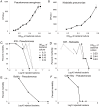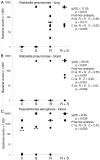Hindlimb suspension and SPE-like radiation impairs clearance of bacterial infections
- PMID: 24454913
- PMCID: PMC3893249
- DOI: 10.1371/journal.pone.0085665
Hindlimb suspension and SPE-like radiation impairs clearance of bacterial infections
Abstract
A major risk of extended space travel is the combined effects of weightlessness and radiation exposure on the immune system. In this study, we used the hindlimb suspension model of microgravity that includes the other space stressors, situational and confinement stress and alterations in food intake, and solar particle event (SPE)-like radiation to measure the combined effects on the ability to control bacterial infections. A massive increase in morbidity and decrease in the ability to control bacterial growth was observed using 2 different types of bacteria delivered by systemic and pulmonary routes in 3 different strains of mice. These data suggest that an astronaut exposed to a strong SPE during extended space travel is at increased risk for the development of infections that could potentially be severe and interfere with mission success and astronaut health.
Conflict of interest statement
Figures









Similar articles
-
Broad-spectrum antibiotic or G-CSF as potential countermeasures for impaired control of bacterial infection associated with an SPE exposure during spaceflight.PLoS One. 2015 Mar 20;10(3):e0120126. doi: 10.1371/journal.pone.0120126. eCollection 2015. PLoS One. 2015. PMID: 25793272 Free PMC article.
-
Effect of solar particle event radiation and hindlimb suspension on gastrointestinal tract bacterial translocation and immune activation.PLoS One. 2012;7(9):e44329. doi: 10.1371/journal.pone.0044329. Epub 2012 Sep 19. PLoS One. 2012. PMID: 23028522 Free PMC article.
-
Leukocyte activity is altered in a ground based murine model of microgravity and proton radiation exposure.PLoS One. 2013 Aug 14;8(8):e71757. doi: 10.1371/journal.pone.0071757. eCollection 2013. PLoS One. 2013. PMID: 23977138 Free PMC article.
-
Anorexia in space and possible etiologies: an overview.Nutrition. 2002 Oct;18(10):805-13. doi: 10.1016/s0899-9007(02)00915-2. Nutrition. 2002. PMID: 12361771 Review.
-
Use of animal models for space flight physiology studies, with special focus on the immune system.Gravit Space Biol Bull. 2005 Jun;18(2):31-5. Gravit Space Biol Bull. 2005. PMID: 16038091 Review.
Cited by
-
How does spaceflight affect the acquired immune system?NPJ Microgravity. 2020 May 7;6:14. doi: 10.1038/s41526-020-0104-1. eCollection 2020. NPJ Microgravity. 2020. PMID: 32411817 Free PMC article. Review.
-
Broad-spectrum antibiotic or G-CSF as potential countermeasures for impaired control of bacterial infection associated with an SPE exposure during spaceflight.PLoS One. 2015 Mar 20;10(3):e0120126. doi: 10.1371/journal.pone.0120126. eCollection 2015. PLoS One. 2015. PMID: 25793272 Free PMC article.
-
Ionizing radiation selectively reduces skin regulatory T cells and alters immune function.PLoS One. 2014 Jun 24;9(6):e100800. doi: 10.1371/journal.pone.0100800. eCollection 2014. PLoS One. 2014. PMID: 24959865 Free PMC article.
-
Limitations in predicting the space radiation health risk for exploration astronauts.NPJ Microgravity. 2018 Apr 3;4:8. doi: 10.1038/s41526-018-0043-2. eCollection 2018. NPJ Microgravity. 2018. PMID: 29644336 Free PMC article. Review.
-
A reproducible radiation delivery method for unanesthetized rodents during periods of hind limb unloading.Life Sci Space Res (Amst). 2015 Jul;6:10-4. doi: 10.1016/j.lssr.2015.05.002. Life Sci Space Res (Amst). 2015. PMID: 26097807 Free PMC article.
References
-
- Meehan R, Whitson P, Sams C (1993) The role of psychoneuroendocrine factors on spaceflight-induced immunological alterations. J Leukoc Biol 54: 236–244. - PubMed
-
- Aponte VM, Finch DS, Klaus DM (2006) Considerations for non-invasive in-flight monitoring of astronaut immune status with potential use of MEMS and NEMS devices. Life Sci 79: 1317–1333. - PubMed
-
- Kita M, Yamamoto T, Imanishi J, Fuse A (2004) Influence of gravity changes induced by parabolic flight on cytokine production in mouse spleen. J Gravit Physiol 11: P67–68. - PubMed
-
- Sastry KJ, Nehete PN, Savary CA (2001) Impairment of antigen-specific cellular immune responses under simulated microgravity conditions. In Vitro Cell Dev Biol Anim 37: 203–208. - PubMed
Publication types
MeSH terms
Substances
LinkOut - more resources
Full Text Sources
Other Literature Sources
Medical

